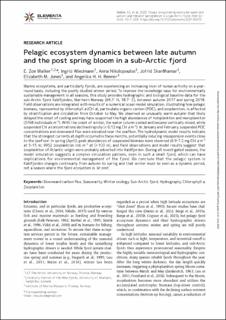| dc.contributor.author | Walker, Emily-Zoe Elizabeth | |
| dc.contributor.author | Wiedmann, Ingrid | |
| dc.contributor.author | Nikolopoulos, Anna | |
| dc.contributor.author | Skardhamar, Jofrid | |
| dc.contributor.author | Jones, Elizabeth Marie | |
| dc.contributor.author | Renner, Angelika | |
| dc.date.accessioned | 2022-06-17T08:05:59Z | |
| dc.date.available | 2022-06-17T08:05:59Z | |
| dc.date.created | 2022-06-02T14:26:36Z | |
| dc.date.issued | 2022 | |
| dc.identifier.issn | 2325-1026 | |
| dc.identifier.uri | https://hdl.handle.net/11250/2999223 | |
| dc.description.abstract | Marine ecosystems, and particularly fjords, are experiencing an increasing level of human activity on a year-round basis, including the poorly studied winter period. To improve the knowledge base for environmentally sustainable management in all seasons, this study provides hydrographic and biological baseline data for the sub-Arctic fjord Kaldfjorden, Northern Norway (69.7° N, 18.7° E), between autumn 2017 and spring 2018. Field observations are integrated with results of a numerical ocean model simulation, illustrating how pelagic biomass, represented by chlorophyll a (Chl a), particulate organic carbon (POC), and zooplankton, is affected by stratification and circulation from October to May. We observed an unusually warm autumn that likely delayed the onset of cooling and may have supported the high abundances of holoplankton and meroplankton (5768 individuals m–3). With the onset of winter, the water column cooled and became vertically mixed, while suspended Chl a concentrations declined rapidly (< 0.12 mg Chl a m–3). In January and February, suspended POC concentrations and downward flux were elevated near the seafloor. The hydrodynamic model results indicate that the strongest currents at depth occurred in these months, potentially inducing resuspension events close to the seafloor. In spring (April), peak abundances of suspended biomass were observed (6.9–7.2 mg Chl a m–3 at 5–15 m; 9952 zooplankton ind. m–3 at 0–100 m), and field observations and model results suggest that zooplankton of Atlantic origin were probably advected into Kaldfjorden. During all investigated seasons, the model simulation suggests a complex circulation pattern, even in such a small fjord, which can have implications for environmental management of the fjord. We conclude that the pelagic system in Kaldfjorden changes continually from autumn to spring and that winter must be seen as a dynamic period, not a season where the fjord ecosystem is ‘at rest’. | en_US |
| dc.language.iso | eng | en_US |
| dc.title | Pelagic ecosystem dynamics between late autumn and the post spring bloom in a sub-Arctic fjord | en_US |
| dc.title.alternative | Pelagic ecosystem dynamics between late autumn and the post spring bloom in a sub-Arctic fjord | en_US |
| dc.type | Peer reviewed | en_US |
| dc.type | Journal article | en_US |
| dc.description.version | publishedVersion | en_US |
| dc.source.journal | Elementa: Science of the Anthropocene | en_US |
| dc.identifier.doi | 10.1525/elementa.2021.00070 | |
| dc.identifier.cristin | 2029144 | |
| dc.relation.project | Framsenteret: WHALE (#201914747042018) | en_US |
| dc.relation.project | EC/H2020/ECOTIP (#869383) | en_US |
| dc.relation.project | Norges forskningsråd: 228107 | en_US |
| dc.relation.project | Norges forskningsråd: 299554 | en_US |
| dc.relation.project | UiT Norges arktiske universitet: Publication fund | en_US |
| cristin.ispublished | true | |
| cristin.fulltext | original | |
| cristin.qualitycode | 1 | |
